A magical place in Norway, great lighting.
Relax and enjoy!
Spirits from Nicholas Buer on Vimeo.

A magical place in Norway, great lighting.
Relax and enjoy!
Spirits from Nicholas Buer on Vimeo.
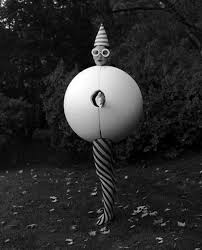 Asymmetry, elegance, beauty and practicality, this describes some of the Bauhaus design curricula. The school emphasized a teaching method that shifted the mindset from competition-focused to a focus on personal potential and universal purpose.
Asymmetry, elegance, beauty and practicality, this describes some of the Bauhaus design curricula. The school emphasized a teaching method that shifted the mindset from competition-focused to a focus on personal potential and universal purpose. 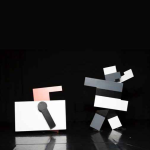 Lead by Walter Gropius, Bauhaus was founded in 1919 in Weimar, Germany. The Bauhaus teaching style resembled a utopian artists’ guild. To set up a new way of living, the Bauhaus taught principles that instituted creative design and technical disciplines. Community living in a unified-designed environment can influence an individual to adopt a more creative design awareness. Design knowledge can add vitality to live a better life. The school moved to Dessau, Germany in 1924. By 1933, the Nazi political party had forced the school to close
Lead by Walter Gropius, Bauhaus was founded in 1919 in Weimar, Germany. The Bauhaus teaching style resembled a utopian artists’ guild. To set up a new way of living, the Bauhaus taught principles that instituted creative design and technical disciplines. Community living in a unified-designed environment can influence an individual to adopt a more creative design awareness. Design knowledge can add vitality to live a better life. The school moved to Dessau, Germany in 1924. By 1933, the Nazi political party had forced the school to close
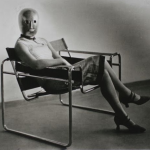
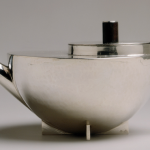 Marcel Breuer and Joseph Albers immigrated to the United States to take teaching positions at Yale. After Walter Gropius went to Harvard, Moholy-Nagy eventually established a New Bauhaus school.
Marcel Breuer and Joseph Albers immigrated to the United States to take teaching positions at Yale. After Walter Gropius went to Harvard, Moholy-Nagy eventually established a New Bauhaus school.
In 1922, Bauhaus principles were introduced in the United States with The Chicago Association of Arts and Industries. The association’s primary purpose was to open a school of design. Funding to initiate the New Bauhaus school was a major problem. Maholy-Nagy’s hard work and persistence eventually led to the opening of The School of Design in 1939. A few years later in 1944, a new board of directors dissolved The School of Design and formed the new Institute of Design. What started out as an artists’ guild and design school with a pedagogical teaching approach in Germany, evolved into one of the most prestigious industrial design graduate schools in the United States, the Illinois Institute of Technology – Institute of Design.
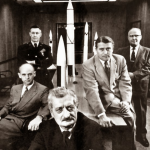 As World War II progressed, the import of other highly regarded Germans was essential to the U.S. war effort. A secret project “Operation Paperclip” involved 88 German scientists and rocket technology production. Other German scientists provided necessary help developing the Atomic Bomb.
As World War II progressed, the import of other highly regarded Germans was essential to the U.S. war effort. A secret project “Operation Paperclip” involved 88 German scientists and rocket technology production. Other German scientists provided necessary help developing the Atomic Bomb.
The video shows a quick fundamental review of the Bauhaus School’s history, philosophy and achievements.
The Swiss-German Paul Klee (December 18, 1879 – June 29, 1940) taught in Weimar, Germany’s Bauhaus school of art, design, and architecture, with Russian painter Wassily Kandinsky. Klee’s lecture writings, Paul Klee Notebooks, on form and design theory, became one of the most respected in the Modern art movement. Klee’s extensive work in color theory allowed the experimentation to express moods, beliefs, dry humor, and his childlike perspective. In 1919, at the Academy of Art in Stuttgart, Klee created artworks influenced by Expressionism, Cubism, Futurism, Surrealism, and Abstraction. The artwork produced is difficult to categorize because Klee combines and morphs the various art movement styles to create his own. He usually worked alone and analyzed art trends based on his perspective. Klee used inventive methods and techniques to apply many media types to different painting surfaces. Over the years, Klee created about 9000 artworks. The videos combined show a small amount of Klee’s artwork accompanied by music.
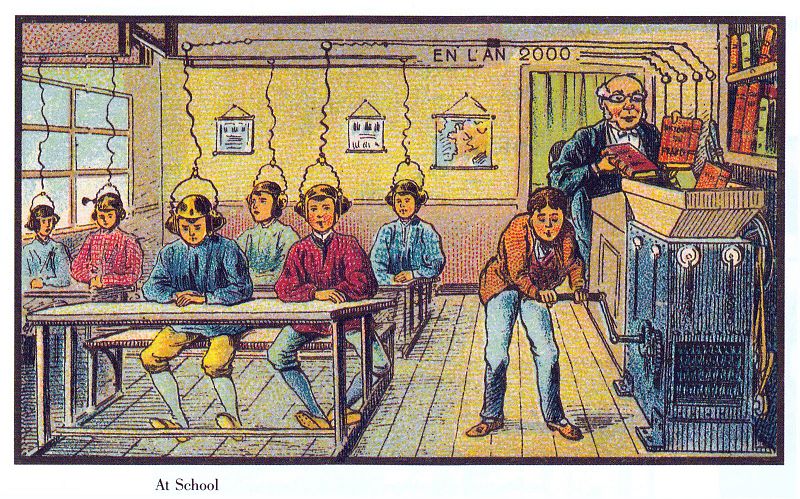 Around the year 1900, various French, German and Russian artists expressed their vision of the next century on small labels and cards. The art created was derived from the artists’ current environmental, social and technological viewpoint. Some of the artworks are very imaginative but departs from what we would think of as practical. The artists illustrated the idea of great and small public flying vehicles. The idea they expressed is not likely to happen at any time in near the future. The artists dreamed of automation and robotics that eliminated hard labor and personal chores to create a better lifestyle. The art shows technology that adds fun to a sport and other social events that take place on the ground, in water and the air. Inventive scenarios of technology, science and industry seem to still have relevance today. It is apparent the artists did not consult fashion designers on what clothes would look like in the future. By today’s standards, the attire that is worn underwater is quite entertaining.
Around the year 1900, various French, German and Russian artists expressed their vision of the next century on small labels and cards. The art created was derived from the artists’ current environmental, social and technological viewpoint. Some of the artworks are very imaginative but departs from what we would think of as practical. The artists illustrated the idea of great and small public flying vehicles. The idea they expressed is not likely to happen at any time in near the future. The artists dreamed of automation and robotics that eliminated hard labor and personal chores to create a better lifestyle. The art shows technology that adds fun to a sport and other social events that take place on the ground, in water and the air. Inventive scenarios of technology, science and industry seem to still have relevance today. It is apparent the artists did not consult fashion designers on what clothes would look like in the future. By today’s standards, the attire that is worn underwater is quite entertaining.
Futurism became one of the most important Italian modern art movements of the early 20th century. Committed to new technology and mobility, its members wanted to change the culture and demonstrate the advancements of modern life. The artists worked in traditional media such as painting and sculpture, in styles influenced by Post-Impressionism. They were interested in embracing popular social subjects, media, and new technologies to communicate their ideas as many artists do today.
There is a young Sir Michael Caine in this painting.
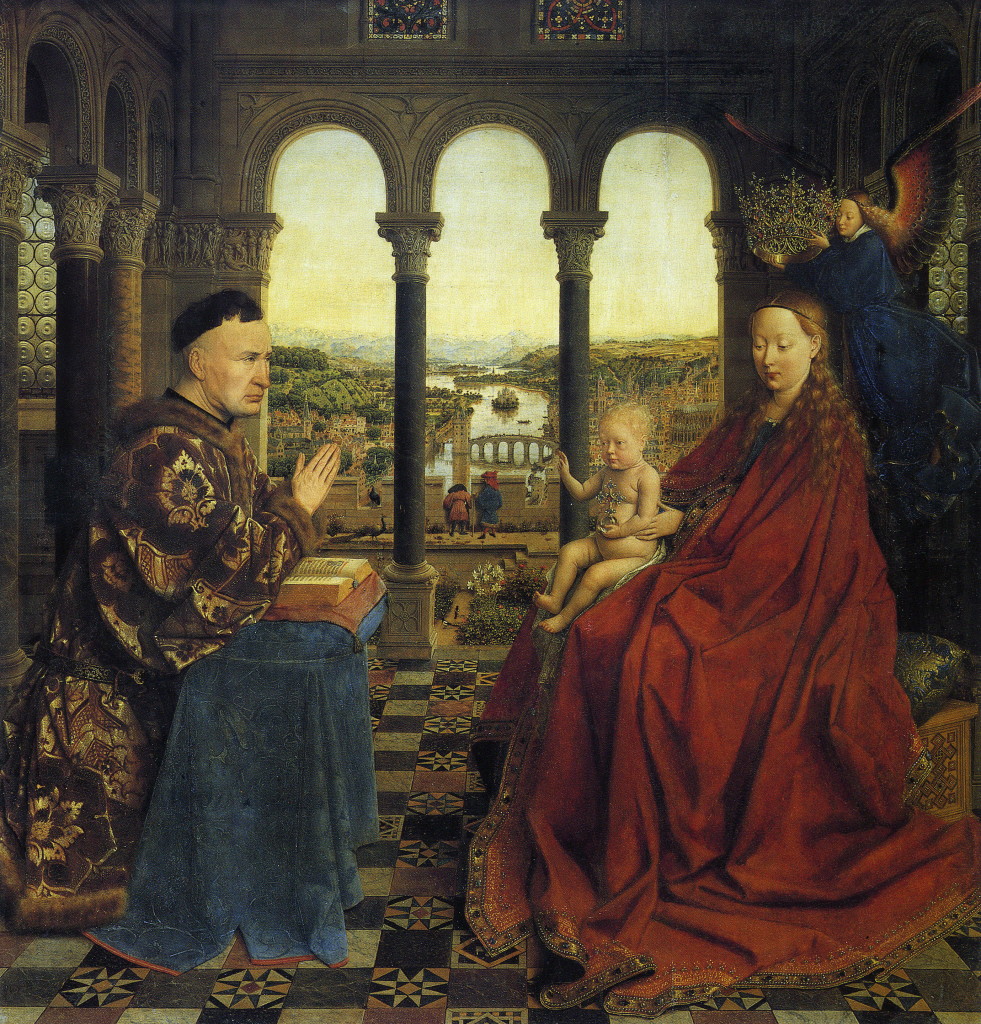
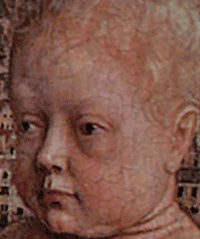 Sir Michael CBE, English actor and author is well known for his unique working class cockney accent. Caine has had a roll in over 115 films and is regarded as a British film icon. Now he is playing the baby Jesus in this painting by Jan van Eyck, Madonna of Chancellor Rolin c. 1435
Sir Michael CBE, English actor and author is well known for his unique working class cockney accent. Caine has had a roll in over 115 films and is regarded as a British film icon. Now he is playing the baby Jesus in this painting by Jan van Eyck, Madonna of Chancellor Rolin c. 1435
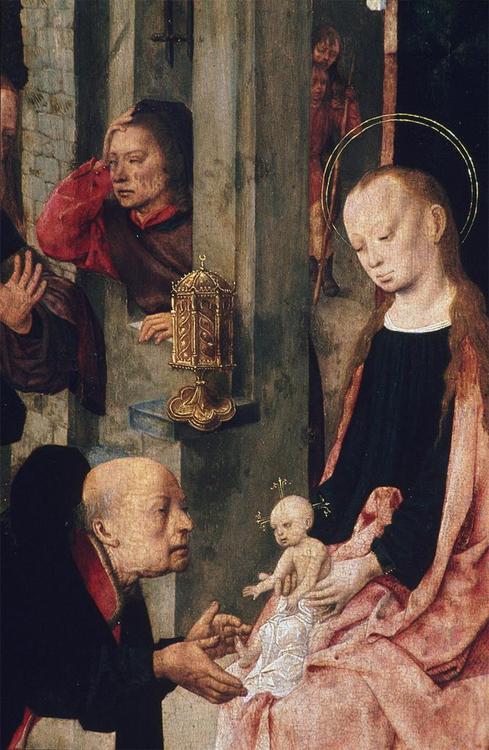
I guess there had to be some heavy medication in the Renaissance. The baby in this painting appears to be premature and is sprouting something.
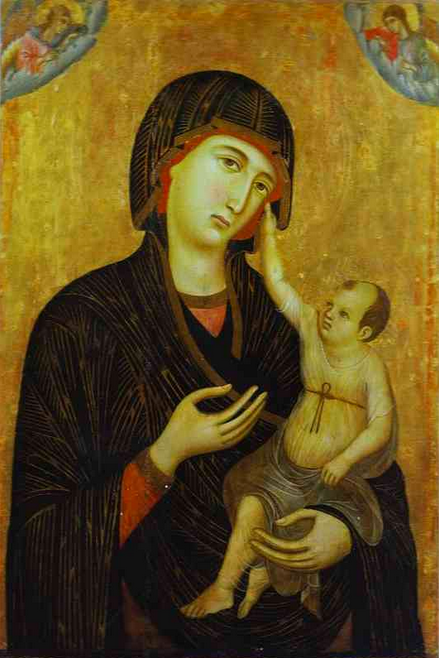
There is nothing like having sideburns and a receding hairline at such an early age.
Painting by Duccio di Buoninsegna c. 1283-1284
I do not guess Gravity nor table legs are an issue in this Renaissance workshop.
The Mérode Altarpiece c. 1425-30
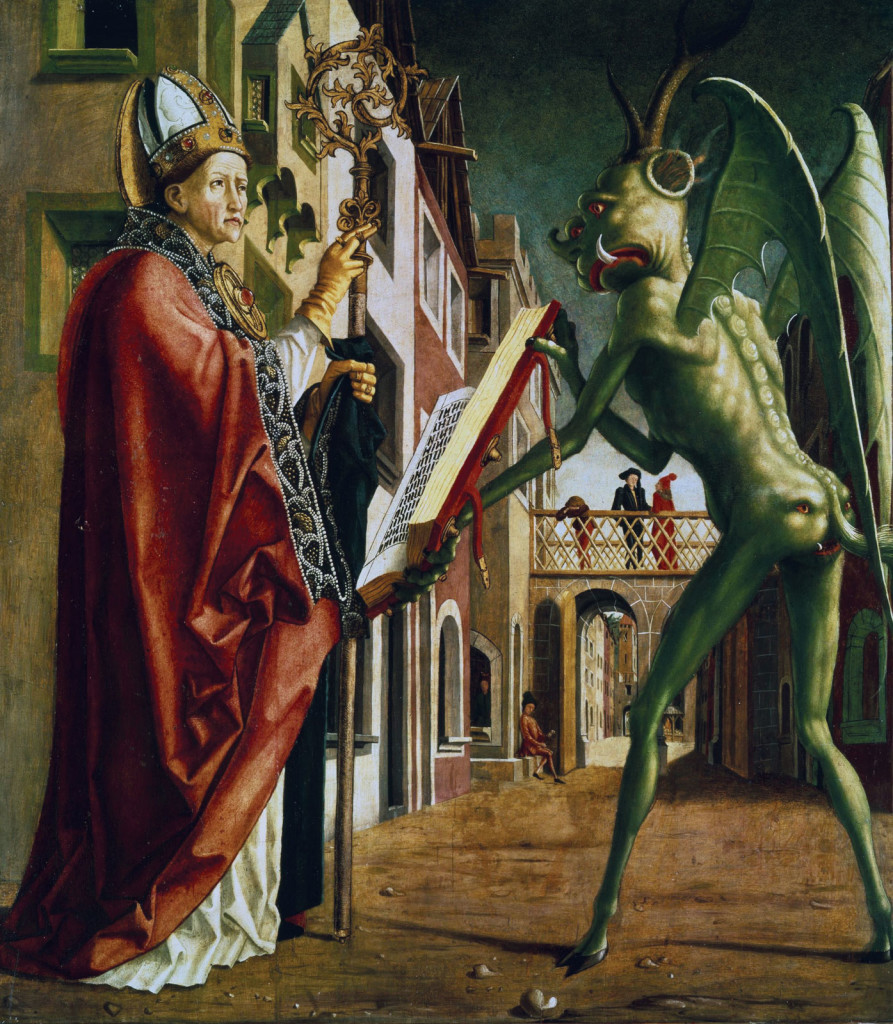
Michael Pacher, The Devil Presenting St. Augustine with the Book of Vices c. 1475
by Bailey Dolenc
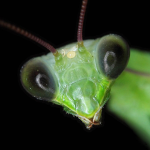 Ruth Markus in her article “Surrealism’s Praying Mantis and Castrating Woman” explains the Surrealists’ demonic beliefs of women and the artworks depicting them during the late 1920s into the mid-1930s. Markus makes it clear that Surrealist painters such as Dali, Ernst, and Picasso had a disturbing complex concerning women. The woman was a symbol of sexual desire and devouring death, concepts derived from the sexual rites of the praying mantis. During copulation the female overpowers the male and decapitates him, leaving him to die. No matter the artist’s personal dilemma, the concept of the decapitating praying mantis, otherwise named the castrating woman or the vagina dentata, was central to relationships between men and females. Markus delves into indigenous beliefs ranging from the Native North American tribes to the Bushmen to further unravel and rationalize the male fear of the castrating woman.
Ruth Markus in her article “Surrealism’s Praying Mantis and Castrating Woman” explains the Surrealists’ demonic beliefs of women and the artworks depicting them during the late 1920s into the mid-1930s. Markus makes it clear that Surrealist painters such as Dali, Ernst, and Picasso had a disturbing complex concerning women. The woman was a symbol of sexual desire and devouring death, concepts derived from the sexual rites of the praying mantis. During copulation the female overpowers the male and decapitates him, leaving him to die. No matter the artist’s personal dilemma, the concept of the decapitating praying mantis, otherwise named the castrating woman or the vagina dentata, was central to relationships between men and females. Markus delves into indigenous beliefs ranging from the Native North American tribes to the Bushmen to further unravel and rationalize the male fear of the castrating woman.
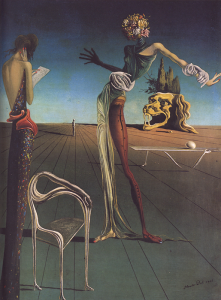 Salvador Dali’s painting A Women with a Head of Roses (1935) is a symbolic expression that further illustrates Markus’s theory with the small male figure in the background watched and dominated by a monstrous skull-shaped hill. In the foreground the bouquet-headed woman dominates the scene, making herself beautiful to elicit deceptive devouring death.
Salvador Dali’s painting A Women with a Head of Roses (1935) is a symbolic expression that further illustrates Markus’s theory with the small male figure in the background watched and dominated by a monstrous skull-shaped hill. In the foreground the bouquet-headed woman dominates the scene, making herself beautiful to elicit deceptive devouring death.
In Ernst’s painting Joy of Life (jungle) of 1936, the forests and tangled undergrowth are derived from the rich Romantic heritage in German art. Upon closer inspection, the title becomes bitterly ironic. The jungle has grown enormous, dwarfing a sculpture of a woman and an animal living together in harmony.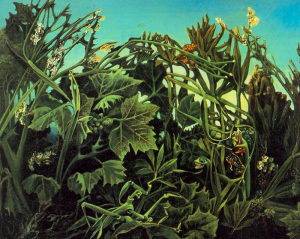 Instead of a paradise, the scene is scary in which giant praying mantises do battle. The mantises also symbolize the fears and suppressed desires of the human mind. The female mantis overpowers the male mantis, symbolizing the metamorphic and deceptive qualities of women. Picasso’s painting The Kiss (1931), Markus adds, ultimately liberates the female from being the aggressor.
Instead of a paradise, the scene is scary in which giant praying mantises do battle. The mantises also symbolize the fears and suppressed desires of the human mind. The female mantis overpowers the male mantis, symbolizing the metamorphic and deceptive qualities of women. Picasso’s painting The Kiss (1931), Markus adds, ultimately liberates the female from being the aggressor. 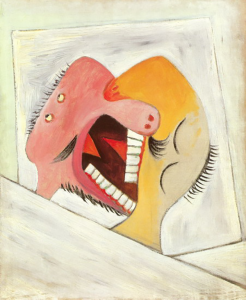
Abstract:
The iconographic praying mantis became a primary inspiration for the Surrealists, mainly due to the outcome of its bizarre mating ritual in which the female devours the male during and after copulating. Scientists such as Sigmund Freud with his writings on man’s repressed sexuality influenced the Surrealists artists. The Surrealists discovered the insect’s cannibalistic marriage a fascinating image of the hypothetical erotic viciousness lurking in the murkier recesses of the human mind. Although other insects act identically, the mantis with its extremely humanoid form is further symbolized by the scientific observations of J. H. Fabre. Fabre’s descriptions gave his insect subjects a more poetic and imaginative life.
(Jean-Henri Casimir Faber was a famous French scientist who devoted his whole life to working in entomology)
2000 – Ruth Markus, “Surrealism’s Praying Mantis and Castrating Woman”, Woman’s Art Journal, vol. 21;1, Spring/Summer, 2000; (33-39).
Dr. Ruth Markus
Education:
1985-1997 – Tel-Aviv University, History of Art
1998 – Ph.D.
Title of Doctoral Dissertation: “Linear Sculpture between the Two World Wars”, supervised by Prof. G. Ballas.
1977-1984 – Tel-Aviv University, History of Art
1984 – M. A. (with distinction)
Title of Master’s Thesis: “The Aspiration to Abolish the Mass: Towards Linear Sculpture: Cubism, Futurism, Constructivism”, supervised by Prof. M. Omer
1972-1977 – Tel-Aviv University, Theatre Studies
1977 – B. A. (with distinction)